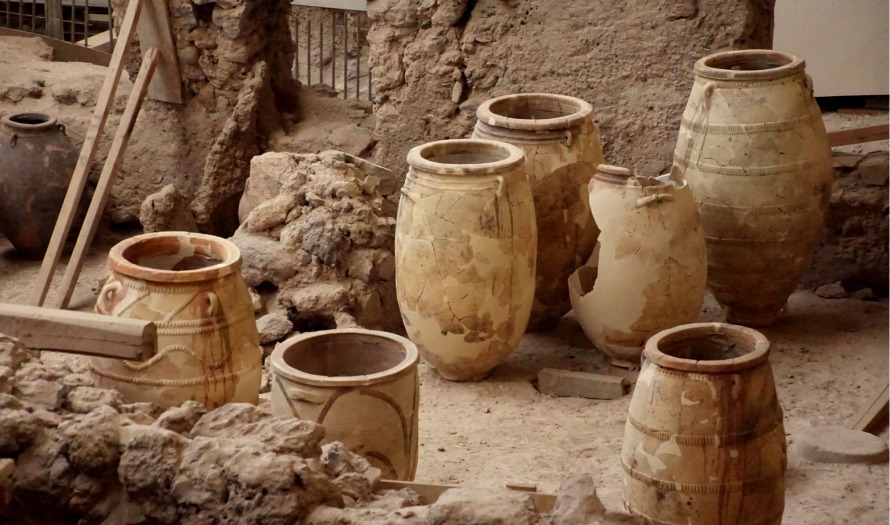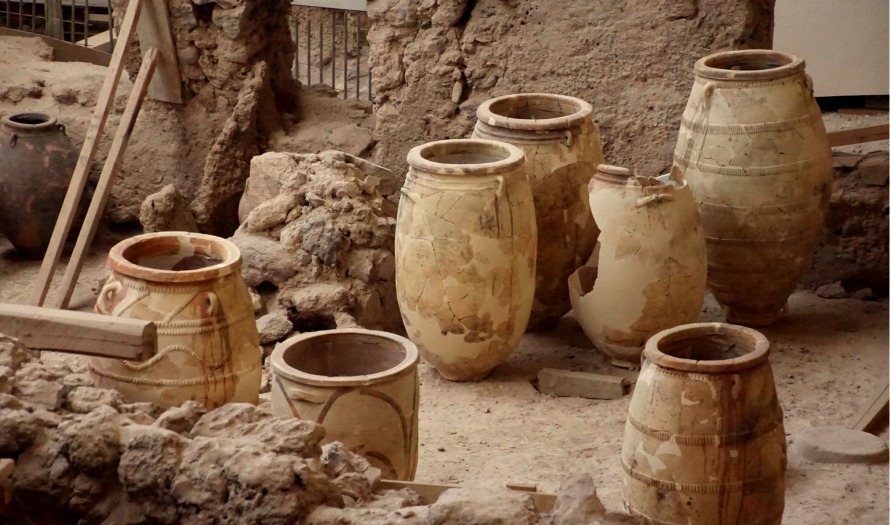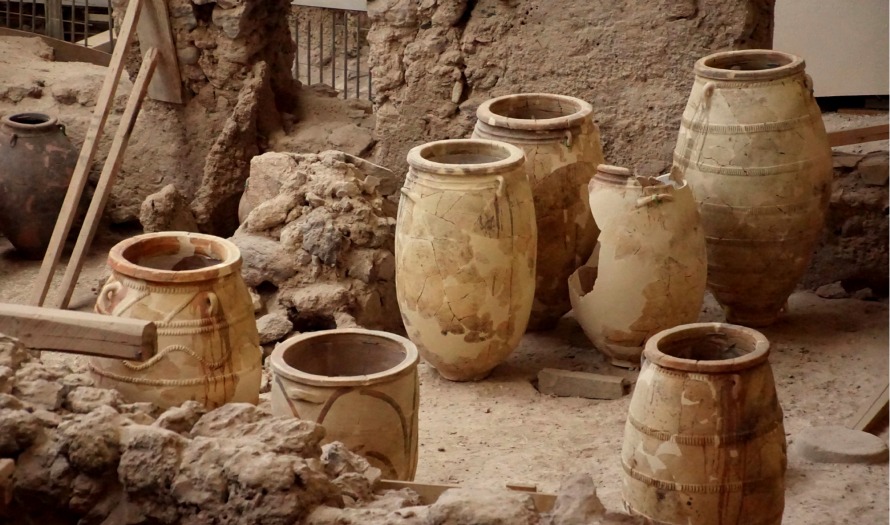General information
For ages Oia was called Epano Meria (Upper Side), since it is built in the northern side of the island. It is an impressive settlement known all over the world for the magnificent sunset from its Goulas. In recent years the buildings have become hotels, restaurants, cafes, stores.
The settlement is very popular and therefore from dawn till dusk it is filled with visitors. Nights in Oia remain peaceful though, and walking in the center marble laid road, loitering the impressive and exquisitely lit buildings is a real pleasure.
During the sunset, tens of people full of awe from the greatness they face, sit on roofs and balconies silently admiring one of the most rare spectacles on earth.
Carved-in buildings and captains’ houses
Characteristics of the settlement are its carved-in buildings and the so called captains’ houses (“kapetanospita”) having unusual neoclassic elements. As writer Kadio Kolimva from Oia notes: “…carved-in buildings of Oia with stubbornness from the downslope are trying to find a space to exist. Houses without foundations spread out in the light, illuminated early, with nothing to disturb their concatenation of lines and colors. Always at the front, a very small courtyard with a tiny “alitana”, a flower-bed with fragrant jasmines, honeysuckles, verbenas and lavenders”.
In 1993, Oia was characterized as a traditional settlement by presidential decree, and the entire island of Santorini as an area of “exceptional natural beauty”.
History
The castle or Goulas of Aghios Nikolaos (Saint Nicholas)- present-day Oia, or Epano Meria (Upper Side), – was built at the northwest tip of the island. The settlement was named after the church of Saint Nicholas built on the volcanic rock in the 15th or 16th century.
Later on, at the centre of the fortified village stood the Cathedral of Panagia Akathistos Ymnos (Unseated Virgin Mary Hymn), or Platsani.
A defensive hub is believed to have existed here since 1480, ruled by the Dargentas, Latinized Greeks claiming to be descendants of the Byzantine emperor Romanus III Argyrus. They remained in charge of the Upper Side until 1577.
In 1579, the Duchy of the Aegean was handed over to the Ottomans and so the Upper Side, and the rest of the island alike, remained under their rule for 250 years.
The count down started for Epano Meria, while raids of pirates continued, the population kept decreasing and the castle did not offer enough protection for the residents.
In 1650, Culumbos, the submarine volcano northeast of Oia, erupted violently, and volcanic activity continued for two months. It was then followed by earthquakes and ejections of volcanic ash and thunders heard as far as Chios and Dardanelia.
Years of prosperity
Development resumed in 1850. As province of the newborn Greek state, it relied on the shipping industry and commerce, therefore it was called “village of captains”.
In 1890, there were around 2,500 inhabitants, 130 ships, a shipyard at Armeni bay, 13 parishes, a bank, a customs office, small factories etc. Agriculture was also developed.
Later on, various factors –such as the emergence of steamships, the shutting down of the small factory operating there, the earthquakes of 1928 and 1956 – led to the decline of the community.
The earthquake
The effects of the 1956 earthquake were particularly severe, since parts of the ground collapsed into the sea. The churches of Panagia Platsani and Aghios (St) Georgios were destroyed. Oia was deserted as people left the island and moved to Piraeus, Drapetsona, and Lavrio. This is quite hard to imagine when seeing Oia today…
The locals returned in the 1980s, and gradually the village came back to life. The contribution of the Greek National Tourism Organization (GNTO) was quite significant: In the years between 1976 and 1991, 60 traditional buildings at the centre of Oia were restored, as well as in Perivolas and Ammoudi, to be used as guesthouses.
The castle of St. Nicholas
During the Venetian Rule, as was the case in all islands, a society of great inequalities between classes was built up and the locals served as vassals.
Coming here, Venetian Catholics and other families from Spain, Portugal, and France, took refuge inside the castle for the fear of pirates.
As in other regions of the island, a Goulas was built (from the Turkish word “su kulesi”, tower, observatory), where guards scouted the horizon and gave the alarm. If they could not counter the attacker, they locked down themselves inside and whoever stayed outside run for cover in the plain.
Their two and three-story houses, built on the rocks, stood close to, or on top of, each other; their external walls, devoid of openings, formed a protective perimeter around the castle and the village.
Limited by the rocky ground of the settlement, the narrow backstreets called “rimidia”, resembled a labyrinth. The most impressive residence in the castle was that of Kastelano of Darzenta’s family of Epano Meria and the other houses of his relatives. There were also the residences of the aristocrats where they enjoyed special privileges and to whom the Latins had granted feuds. Latins and nobles gathered in the Club of the Nobles.
The residential area, in time, expanded to the west above Ammoudi and included the mills, which belonged to the feudal lords, for their protection. Here barley and beans were grinded, and the complexes had also ovens.
The neighborhoods
The 1,000 buildings of the community of Oia are divided into four neighborhoods:
THE CAPTAINS’ neighbourhood located at the northern part of the village, also called Sideras (Blacksmith). It is worth noting that there is a section of Oia comprising solely ship owners’ mansions from the 19th and early 20th centuries. In the 20th-century houses, one can distinguish influences by the Renaissance architecture. Neoclassical features and local architectural elements were combined in most mansions, which look quite impressive, made of local red and black rocks. Remains of their colouring and wounds from past earthquakes are still visible.
THE CREWS’ neighborhood, on the Caldera side, includes rock-hewn houses densely built, forming beautiful arrangements.
THE NEIGHBOURHOOD OF PERIVOLAS FARMERS. The eastern quarter of Oia is now connected to the rest of the village. This is where the farmhouses with the kanaves (wineries) used to be; now, most of them have been turned into hotels.
THE NEW NEIGHBOURHOOD. These houses were built after the 1956 earthquake; this is where most locals live today.
Walking around
Oia is characterized by its harmoniously combined architectural “units”. Like Imerovigli and Therasia, it has expanded linearly along the edge of the cliff in a 50-acre area.
The close-knit neighborhoods with the rock-hewn houses and the so-called “captains’ houses” (a type of mansion quite common throughout the Mediterranean) look stunningly beautiful in their multicolor variety: white, ochre, burgundy, purple, blue, pink, red, and grey.
The hub of the village’s life is the main marble-paved pedestrian street. The Venetian district, built at the site of the old Goulas –a watchtower used during the rule of the Westerners– was ruined by the earthquakes.
The meeting point for locals and foreigners alike is Platsani square, where people gaze at the Caldera and the village. In one direction, the main marble-paved pedestrian street leads to the Goulas. It is lined with shops, cafés, restaurants. Walking towards the Goulas, you will see the church of Eisodia tis Theotokou (the Presentation of Virgin Mary), the clock built in 1952 and the blue coppola of Aghios Nikolaos (St. Nicholas).
In the other direction, the pedestrian street leads to Perivolas.
The sunset
The sunset in Oia is a pole of attraction on the island during the summer and is famous all over the world. Visitors fill the narrow streets and then swarm around the castle ruins, strike poses, take pictures and videos. When the fiery disk finally sinks into the horizon they usually applaud.
There are also other places on the island to enjoy the sunset.
- Around Oia you may go to the church of Ai Giannis Thalassinos (Saint John of the Sea) at the lighthouse, the hill of Kyra Panagia (Virgin Mary), the area of Baxedes, and the yard of Panagia Matrona (the Hostess Virgin Mary) in the village of Finikia. The view over Oia and Therassia is also magnificent from the small church of Ai Lias (Saint Elias), in the upper part of this village.
- In Imerovigli you can visit the rock of Skaros.
- In Fira you may choose Kato Fira or the area of the old mines next to the town.
- Other great sunset locations are the lighthouse in Akrotiri and the medieval castle of Pyrgos.
- General information
-
General information
For ages Oia was called Epano Meria (Upper Side), since it is built in the northern side of the island. It is an impressive settlement known all over the world for the magnificent sunset from its Goulas. In recent years the buildings have become hotels, restaurants, cafes, stores.
The settlement is very popular and therefore from dawn till dusk it is filled with visitors. Nights in Oia remain peaceful though, and walking in the center marble laid road, loitering the impressive and exquisitely lit buildings is a real pleasure.
During the sunset, tens of people full of awe from the greatness they face, sit on roofs and balconies silently admiring one of the most rare spectacles on earth.Carved-in buildings and captains’ houses
Characteristics of the settlement are its carved-in buildings and the so called captains’ houses (“kapetanospita”) having unusual neoclassic elements. As writer Kadio Kolimva from Oia notes: “…carved-in buildings of Oia with stubbornness from the downslope are trying to find a space to exist. Houses without foundations spread out in the light, illuminated early, with nothing to disturb their concatenation of lines and colors. Always at the front, a very small courtyard with a tiny “alitana”, a flower-bed with fragrant jasmines, honeysuckles, verbenas and lavenders”.
In 1993, Oia was characterized as a traditional settlement by presidential decree, and the entire island of Santorini as an area of “exceptional natural beauty”. - History
-
History
The castle or Goulas of Aghios Nikolaos (Saint Nicholas)- present-day Oia, or Epano Meria (Upper Side), – was built at the northwest tip of the island. The settlement was named after the church of Saint Nicholas built on the volcanic rock in the 15th or 16th century.
Later on, at the centre of the fortified village stood the Cathedral of Panagia Akathistos Ymnos (Unseated Virgin Mary Hymn), or Platsani.
A defensive hub is believed to have existed here since 1480, ruled by the Dargentas, Latinized Greeks claiming to be descendants of the Byzantine emperor Romanus III Argyrus. They remained in charge of the Upper Side until 1577.
In 1579, the Duchy of the Aegean was handed over to the Ottomans and so the Upper Side, and the rest of the island alike, remained under their rule for 250 years.
The count down started for Epano Meria, while raids of pirates continued, the population kept decreasing and the castle did not offer enough protection for the residents.
In 1650, Culumbos, the submarine volcano northeast of Oia, erupted violently, and volcanic activity continued for two months. It was then followed by earthquakes and ejections of volcanic ash and thunders heard as far as Chios and Dardanelia.Years of prosperity
Development resumed in 1850. As province of the newborn Greek state, it relied on the shipping industry and commerce, therefore it was called “village of captains”.
In 1890, there were around 2,500 inhabitants, 130 ships, a shipyard at Armeni bay, 13 parishes, a bank, a customs office, small factories etc. Agriculture was also developed.
Later on, various factors –such as the emergence of steamships, the shutting down of the small factory operating there, the earthquakes of 1928 and 1956 – led to the decline of the community.The earthquake
The effects of the 1956 earthquake were particularly severe, since parts of the ground collapsed into the sea. The churches of Panagia Platsani and Aghios (St) Georgios were destroyed. Oia was deserted as people left the island and moved to Piraeus, Drapetsona, and Lavrio. This is quite hard to imagine when seeing Oia today…
The locals returned in the 1980s, and gradually the village came back to life. The contribution of the Greek National Tourism Organization (GNTO) was quite significant: In the years between 1976 and 1991, 60 traditional buildings at the centre of Oia were restored, as well as in Perivolas and Ammoudi, to be used as guesthouses. - The castle of St. Nicholas
-
The castle of St. Nicholas
During the Venetian Rule, as was the case in all islands, a society of great inequalities between classes was built up and the locals served as vassals.
Coming here, Venetian Catholics and other families from Spain, Portugal, and France, took refuge inside the castle for the fear of pirates.
As in other regions of the island, a Goulas was built (from the Turkish word “su kulesi”, tower, observatory), where guards scouted the horizon and gave the alarm. If they could not counter the attacker, they locked down themselves inside and whoever stayed outside run for cover in the plain.
Their two and three-story houses, built on the rocks, stood close to, or on top of, each other; their external walls, devoid of openings, formed a protective perimeter around the castle and the village.
Limited by the rocky ground of the settlement, the narrow backstreets called “rimidia”, resembled a labyrinth. The most impressive residence in the castle was that of Kastelano of Darzenta’s family of Epano Meria and the other houses of his relatives. There were also the residences of the aristocrats where they enjoyed special privileges and to whom the Latins had granted feuds. Latins and nobles gathered in the Club of the Nobles.
The residential area, in time, expanded to the west above Ammoudi and included the mills, which belonged to the feudal lords, for their protection. Here barley and beans were grinded, and the complexes had also ovens. - The neighborhoods
-
The neighborhoods
The 1,000 buildings of the community of Oia are divided into four neighborhoods:
THE CAPTAINS’ neighbourhood located at the northern part of the village, also called Sideras (Blacksmith). It is worth noting that there is a section of Oia comprising solely ship owners’ mansions from the 19th and early 20th centuries. In the 20th-century houses, one can distinguish influences by the Renaissance architecture. Neoclassical features and local architectural elements were combined in most mansions, which look quite impressive, made of local red and black rocks. Remains of their colouring and wounds from past earthquakes are still visible.
THE CREWS’ neighborhood, on the Caldera side, includes rock-hewn houses densely built, forming beautiful arrangements.
THE NEIGHBOURHOOD OF PERIVOLAS FARMERS. The eastern quarter of Oia is now connected to the rest of the village. This is where the farmhouses with the kanaves (wineries) used to be; now, most of them have been turned into hotels.
THE NEW NEIGHBOURHOOD. These houses were built after the 1956 earthquake; this is where most locals live today. - Walking around
-
Walking around
Oia is characterized by its harmoniously combined architectural “units”. Like Imerovigli and Therasia, it has expanded linearly along the edge of the cliff in a 50-acre area.
The close-knit neighborhoods with the rock-hewn houses and the so-called “captains’ houses” (a type of mansion quite common throughout the Mediterranean) look stunningly beautiful in their multicolor variety: white, ochre, burgundy, purple, blue, pink, red, and grey.
The hub of the village’s life is the main marble-paved pedestrian street. The Venetian district, built at the site of the old Goulas –a watchtower used during the rule of the Westerners– was ruined by the earthquakes.
The meeting point for locals and foreigners alike is Platsani square, where people gaze at the Caldera and the village. In one direction, the main marble-paved pedestrian street leads to the Goulas. It is lined with shops, cafés, restaurants. Walking towards the Goulas, you will see the church of Eisodia tis Theotokou (the Presentation of Virgin Mary), the clock built in 1952 and the blue coppola of Aghios Nikolaos (St. Nicholas).
In the other direction, the pedestrian street leads to Perivolas. - Sunset
-
The sunset
The sunset in Oia is a pole of attraction on the island during the summer and is famous all over the world. Visitors fill the narrow streets and then swarm around the castle ruins, strike poses, take pictures and videos. When the fiery disk finally sinks into the horizon they usually applaud.
There are also other places on the island to enjoy the sunset.- Around Oia you may go to the church of Ai Giannis Thalassinos (Saint John of the Sea) at the lighthouse, the hill of Kyra Panagia (Virgin Mary), the area of Baxedes, and the yard of Panagia Matrona (the Hostess Virgin Mary) in the village of Finikia. The view over Oia and Therassia is also magnificent from the small church of Ai Lias (Saint Elias), in the upper part of this village.
- In Imerovigli you can visit the rock of Skaros.
- In Fira you may choose Kato Fira or the area of the old mines next to the town.
- Other great sunset locations are the lighthouse in Akrotiri and the medieval castle of Pyrgos.
info
